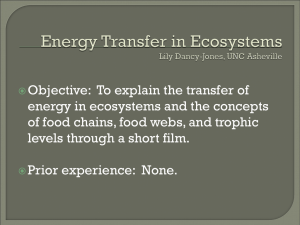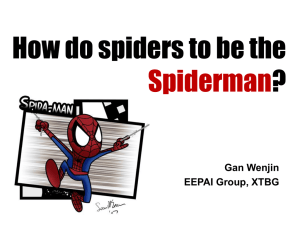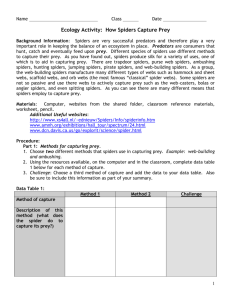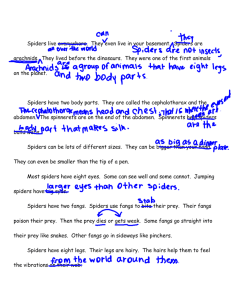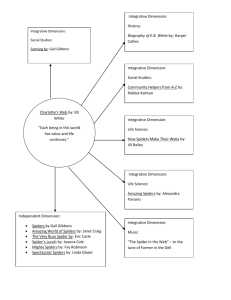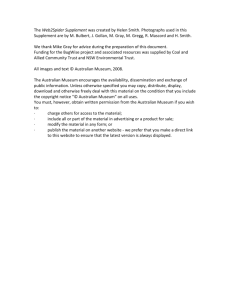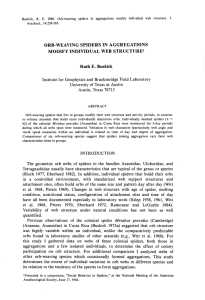Emery
advertisement
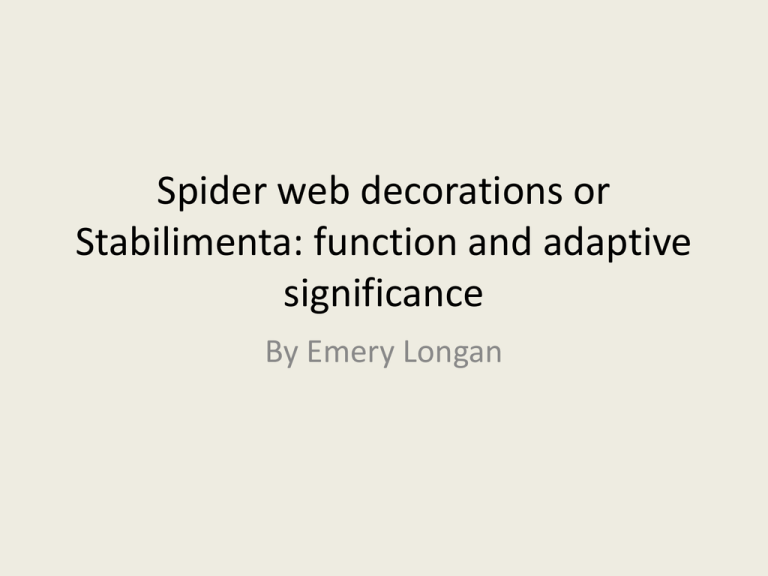
Spider web decorations or Stabilimenta: function and adaptive significance By Emery Longan What are Stabilimenta? • Conspicuous • Break the symmetry of the typical orb web • Made of silk, detritus, and/or egg sacs More general Info • Evolved independently nine times • Ulborodae and Araneidae • Because of independent evolution… – Likely multiple selective pressures brought these about – Likely different selective pressures have allowed for different derived traits Types of Stabilimenta • Disc like Types of Stabilimenta • “X-like” Types of Stabilimenta • Vertical conglomerate Camouflage • First studies found stabilimenta make spiders harder to detect by humans • Spiders orient their body position next to stabilimenta to make outline harder to discern • This orientation is not maintained at night Prey attractant • Thought to be a flower mimic • Or reflect ultraviolet light that attracts insects • Some insects captured more by decorated webs, but some are not Large animal deterrent • Web is valuable resource • Signal large animals of web’s presence, limit inadvertent destruction • Contradictory selective pressure Strengthen the web • If stabilimenta strengthen the web, then we would expect more stabilimenta in windier areas • Often this is not the case • Stabilimenta loosely attached to web • Largely not supported by data Thermoregulation • Juvenile spiders make disc like stabilimenta at a higher frequency • Smaller, more vulnerable to changes in temp • Can thermoregulate using shade provided by stabilimenta • Not fully tested, but intuitively it makes sense Non-adaptive explanations • Silk regulation • Physiological byproduct of stress response In conclusion… • Adaptive significance hard to tease out • Lots of lineages, so probably lots of reasons these structures persisted and continue to persist • However, we can say a few things with decent confidence… Photo credits • http://www.scilogs.fr/best-of-bestioles/files/04Octonoba.yaeyamensis.stabilimentum.1.-.takinawa.jpg • http://farm5.staticflickr.com/4048/4351158397_d9db91a5ae_z.jpg • http://4.bp.blogspot.com/-zFLBolBcHA/VCb5eU3IiTI/AAAAAAAA1r8/GEDHpJkyJvc/s1600/stabilime nta%2Bspider%2Bweb.jpg • http://www.animalbehavioronline.com/spider3.JPG • https://c1.staticflickr.com/9/8110/8602996685_45431e6965_z.jpg • http://wwwdelivery.superstock.com/WI/223/4141/PreviewComp/S uperStock_4141-50394.jpg • http://irvingparkgardenclub.files.wordpress.com/2011/01/bluejay1.jpg • http://breakinggroundgreenroof.com/blog/wpcontent/uploads/BananSpider2_Edited_Web2.jpg References • • • • • • • • • • • • • • Bruce MJ, Herberstein ME, Elgar MA, Bruce MJ. 2001. Signaling conflict between prey and predator attraction : Signal conflict in spiders. J Evol Biol 14(5):786. Blackledge T, Wenzel J, Blackledge TA, Wenzel JW, Blackledge TA. 1999. Do stabilimenta in orb webs attract prey or defend spiders? Behav Ecol 10(4):372. Craig CL. 1994. Limits to learning: Effects of predator pattern and colour on perception and avoidance-learning by prey. Anim Behav 47(5):1087. Craig CL and Bernard GD. 1990. Insect attraction to ultraviolet-reflecting spider webs and web decorations. Ecology 71(2):616-23. Eberhard WG. 1973. Stabilimenta on the webs of uloborus diversus (araneae: Uloboridae) and other spiders. J Zool 171(3):367-84. Eberhard WG. 2003. Substitution of silk stabilimenta for egg sacs by Allocyclosa bifurca (araneae: Araneidae) suggests that silk stabilimenta function as camouflage devices. Behaviour 140(7):847-68. Eisner T and Nowicki S. 1983. Spider web protection through visual advertisement: Role of the stabilimentum. Science 219(4581):185-7. Herberstein ME, Craig CL, Coddington JA, Elgar MA. 2000. The functional significance of silk decorations of orb-web spiders: A critical review of the empirical evidence. Biological Reviews 75(4):649. Jaffé R, Eberhard W, Angelo CD, Eusse D, Gutierrez A, Quijas S, Rodríguez A, Rodríguez M. 2006. Caution, webs in the way! possible functions of silk stabilimenta in gasteracantha cancriformis (araneae, araneidae). J Arachnol 34(2):448-55. Kerr AM. 1993. Low frequency of stabilimenta in orb webs of Argiope appensa (araneae: Araneidae) from Guam: An indirect effect of an introduced avian predator? Pac Sci 47(4):328-37. Lubin YD. 1974. Stabilimenta and barrier webs in the orb webs of Argiope argentata (araneae, araneidae) on Daphne and Santa Cruz Islands, Galapagos. J Arachnol 2(2):119-26. Seah WK and Li D. 2001. Stabilimenta attract unwelcome predators to orb-webs. Proc Biol Sci 268(1476):1553-8. Starks Philip T. 2002. The adaptive significance of stabilimenta in orb-webs: A hierarchical approach. Annales zoologici fennici Helsinki: Suomen Biologian Seura Vanamo, 1964-. 307 p. Tso I. 1996. Stabilimentum of the garden spider Argiope trifasciata: A possible prey attractant. Anim Behav 52(1):183.


